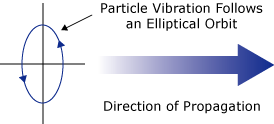Modes of Sound Wave Propagation
After reading this page you will be able to do the following:
- Understand the different types of sound waves in solids.
- Explain the differences between Surface and Plate waves.
In air, sound travels by the compression and rarefaction of air molecules in the direction of travel. However, in solids, molecules can support vibrations in other directions, hence, a number of different types of sound waves are possible. Waves can be characterized in space by oscillatory patterns that are capable of maintaining their shape and propagating in a stable manner. The propagation of waves is often described in terms of what are called “wave modes.”
At surfaces and interfaces, various types of elliptical or complex vibrations of the particles make other waves possible. Some of these wave modes such as Rayleigh and Lamb waves are also useful for ultrasonic inspection.
The table below summarizes many, but not all, of the wave modes possible in solids.
| Wave Types in Solids | Particle Vibrations |
| Longitudinal | Parallel to wave direction |
| Transverse (Shear) | Perpendicular to wave direction |
| Surface - Rayleigh | Elliptical orbit - symmetrical mode |
| Plate Wave - Lamb | Component perpendicular to surface (extensional wave) |
| Plate Wave - Love | Parallel to plane layer, perpendicular to wave direction |
| Stoneley (Leaky Rayleigh Waves) | Wave guided along interface |
| Sezawa | Antisymmetric mode |
Longitudinal and transverse waves were discussed previously, so let's touch on surface and plate waves here.
Surface (or Rayleigh) waves travel the surface of a relatively thick solid material penetrating to a depth of one wavelength. Surface waves combine both a longitudinal and transverse motion to create an elliptic orbit motion as shown in the image and animation below. The major axis of the ellipse is perpendicular to the surface of the solid. As the depth of an individual atom from the surface increases the width of its elliptical motion decreases. Surface waves are generated when a longitudinal wave intersects a surface near the second critical angle and they travel at a velocity between .87 and .95 of a shear wave. Rayleigh waves are useful because they are very sensitive to surface defects (and other surface features) and they follow the surface around curves. Because of this, Rayleigh waves can be used to inspect areas that other waves might have difficulty reaching.

Plate waves are similar to surface waves except they can only be generated in materials a few wavelengths thick. Lamb waves are the most commonly used plate waves in NDT. Lamb waves are complex vibrational waves that propagate parallel to the test surface throughout the thickness of the material. Propagation of Lamb waves depends on the density and the elastic material properties of a component. They are also influenced a great deal by the test frequency and material thickness. Lamb waves are generated at an incident angle in which the parallel component of the velocity of the wave in the source is equal to the velocity of the wave in the test material. Lamb waves will travel several meters in steel and so are useful to scan plate, wire, and tubes.
 With Lamb waves, a number of modes of particle vibration are possible, but the two most common are symmetrical and asymmetrical. The complex motion of the particles is similar to the elliptical orbits for surface waves. Symmetrical Lamb waves move in a symmetrical fashion about the median plane of the plate. This is sometimes called the extensional mode because the wave is “stretching and compressing” the plate in the wave motion direction. Wave motion in the symmetrical mode is most efficiently produced when the exciting force is parallel to the plate. The asymmetrical Lamb wave mode is often called the “flexural mode” because a large portion of the motion moves in a normal direction to the plate, and a little motion occurs in the direction parallel to the plate. In this mode, the body of the plate bends as the two surfaces move in the same direction.
With Lamb waves, a number of modes of particle vibration are possible, but the two most common are symmetrical and asymmetrical. The complex motion of the particles is similar to the elliptical orbits for surface waves. Symmetrical Lamb waves move in a symmetrical fashion about the median plane of the plate. This is sometimes called the extensional mode because the wave is “stretching and compressing” the plate in the wave motion direction. Wave motion in the symmetrical mode is most efficiently produced when the exciting force is parallel to the plate. The asymmetrical Lamb wave mode is often called the “flexural mode” because a large portion of the motion moves in a normal direction to the plate, and a little motion occurs in the direction parallel to the plate. In this mode, the body of the plate bends as the two surfaces move in the same direction.
The generation of waves using both piezoelectric transducers and electromagnetic acoustic transducers (EMATs) are discussed in later sections.
Review:
- At surfaces and interfaces there can be complex vibrations that make other types of waves like Rayleigh and Lamb waves possible.
- Surface/Rayleigh waves travel the surface of a relatively thick solid material and are very sensitive to surface defects.
- Lamb waves are complex vibrational waves that propagate parallel to the test surface throughout the thickness of the material.